Explore the beauty of nature with our guide to Trees that start with ‘I‘. From iconic species like the Italian Cypress to lesser-known varieties, uncover their unique characteristics and learn how to enhance your landscape with these graceful arboreal wonders.
Trees are amazing parts of nature. They make our world prettier and help keep our air clean. Today, we’re going to learn about trees that start with the letter ‘I’. These trees are special and have many cool features. Let’s explore them together!
1. Italian Cypress (Cupressus sempervirens)

Here’s a detailed and verified chart for the Italian Cypress (Cupressus sempervirens):
| Category | Details |
|---|---|
| Botanical Name | Cupressus sempervirens |
| Common Name | Italian Cypress |
| Plant Name | Italian Cypress |
| Zone | Typically zones 7-10 |
| Sun Exposure | Full sun |
| Soil Type | Well-draining, prefers alkaline soil |
| Watering | Moderate; drought-tolerant once established |
| Growth Habit | Evergreen coniferous tree |
| Height/Spread | 40-60 feet tall, 3-6 feet wide (narrow columnar shape) |
| Special Features | Tall, narrow form with dense, dark green foliage; iconic in Mediterranean landscapes; tolerant of coastal conditions and urban environments; used for formal landscaping and as a windbreak |
The Italian Cypress is a tall, thin tree that looks like a green column. It can grow up to 60 feet tall but stay only 3-5 feet wide. This tree is famous in Italy and other Mediterranean countries.
Italian Cypresses have dark green leaves that stay on the tree all year. They make small, round cones that look like nuts.
These trees like warm, sunny places. They don’t need much water once they’re grown. People often plant them to make living fences or to add a tall, green accent to gardens.
2. Indian Sandalwood (Santalum album)

Here’s a detailed and verified chart for Indian Sandalwood (Santalum album):
| Category | Details |
|---|---|
| Botanical Name | Santalum album |
| Common Name | Indian Sandalwood |
| Plant Name | Indian Sandalwood tree |
| Zone | Typically zones 10-12 |
| Sun Exposure | Partial shade to full sun |
| Soil Type | Well-draining, sandy or loamy soil |
| Watering | Regular; prefers well-drained soil |
| Growth Habit | Semi-parasitic evergreen tree |
| Height/Spread | Up to 30 feet tall, 15-20 feet wide |
| Special Features | Highly aromatic heartwood used in perfumes and incense; slow-growing; requires host plants for optimal growth; culturally and economically significant in India and Southeast Asia for its valuable wood and oil |
Indian Sandalwood is a special tree known for its sweet-smelling wood. This tree grows slowly and can live for many years.
The wood of the Indian Sandalwood is very valuable. People use it to make perfumes, medicines and beautiful carved items.
These trees have smooth, gray bark and leaves that stay green all year. They need a warm climate to grow well.
3. Ironwood (Ostrya virginiana)

Here’s a detailed and verified chart for Ironwood (Ostrya virginiana):
| Category | Details |
|---|---|
| Botanical Name | Ostrya virginiana |
| Common Name | Ironwood |
| Plant Name | Ironwood tree |
| Zone | Typically zones 3-9 |
| Sun Exposure | Full sun to partial shade |
| Soil Type | Well-draining, prefers fertile soil |
| Watering | Moderate; drought-tolerant once established |
| Growth Habit | Deciduous tree |
| Height/Spread | 30-50 feet tall, 20-35 feet wide |
| Special Features | Hard, dense wood; finely-toothed leaves; hop-like fruits; provides wildlife habitat; used in woodworking for its strength and durability |
Ironwood trees are tough! Their wood is very hard, which is how they got their name. These trees are also called Hop Hornbeam.
Ironwoods have leaves with jagged edges that turn yellow in fall. Their bark looks like it’s peeling off in thin strips.
These trees can grow in many different places. They don’t mind shade and can live under bigger trees in forests.
Learn more about Ironwood trees at the U.S. Forest Service website.
4. Indian Laurel (Ficus microcarpa)
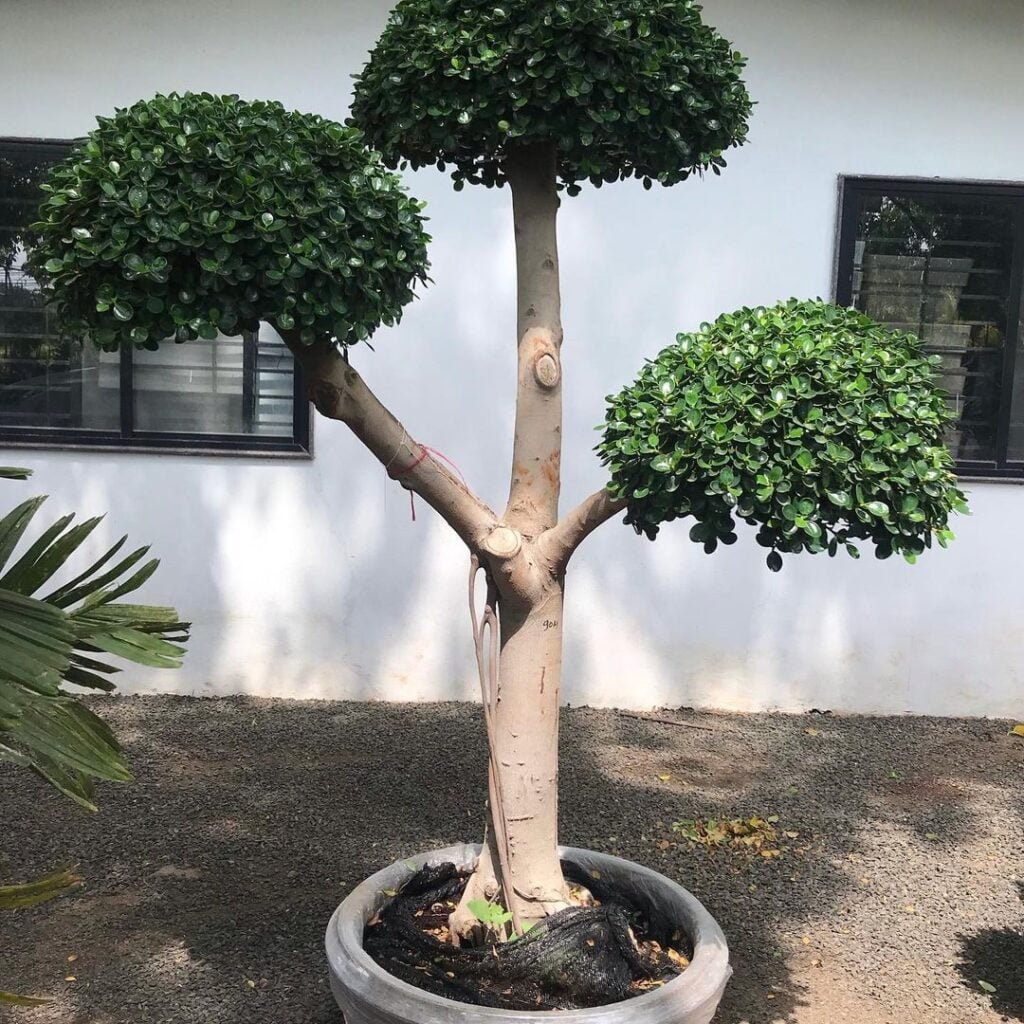
Here’s a detailed and verified chart for Indian Laurel, also known as Ficus microcarpa:
| Category | Details |
|---|---|
| Botanical Name | Ficus microcarpa |
| Common Name | Indian Laurel, Chinese Banyan |
| Plant Name | Indian Laurel |
| Zone | Typically zones 10-11 |
| Sun Exposure | Full sun to partial shade |
| Soil Type | Well-draining, fertile soil |
| Watering | Regular; prefers consistently moist soil |
| Growth Habit | Evergreen tree or large shrub |
| Height/Spread | Up to 50 feet tall and wide (depending on variety) |
| Special Features | Dense, glossy foliage; aerial roots; often used as a shade tree in tropical and subtropical landscapes; tolerant of urban conditions; commonly used for bonsai cultivation |
The Indian Laurel is a big, shady tree. It’s also called the Chinese Banyan. This tree can grow very wide and has lots of branches.
Indian Laurels have dark green, shiny leaves that stay on the tree all year. They make small fruits that birds like to eat.
These trees are often planted in parks and along streets in warm places. They give nice shade and can help make cities cooler.
5. Incense Cedar (Calocedrus decurrens)

Here’s a detailed and verified chart for Incense Cedar (Calocedrus decurrens):
| Category | Details |
|---|---|
| Botanical Name | Calocedrus decurrens |
| Common Name | Incense Cedar |
| Plant Name | Incense Cedar tree |
| Zone | Typically zones 6-8 |
| Sun Exposure | Full sun to partial shade |
| Soil Type | Well-draining, loamy soil |
| Watering | Regular; drought-tolerant once established |
| Growth Habit | Evergreen coniferous tree |
| Height/Spread | 50-75 feet tall, 15-30 feet wide |
| Special Features | Aromatic wood used for incense and construction; attractive, dense foliage; pyramidal shape when young, becoming more open with age; tolerant of various soil types and urban conditions; provides habitat for wildlife |
The Incense Cedar is a tall tree that smells nice. It grows naturally in the western United States.
This tree has scale-like leaves that grow in flat sprays. The bark is thick and reddish-brown. When you crush the leaves or scratch the bark, it gives off a sweet, spicy smell.
People use Incense Cedar wood to make pencils and closet linings because it smells good and resists moths.
6. Irish Yew (Taxus baccata ‘Fastigiata’)
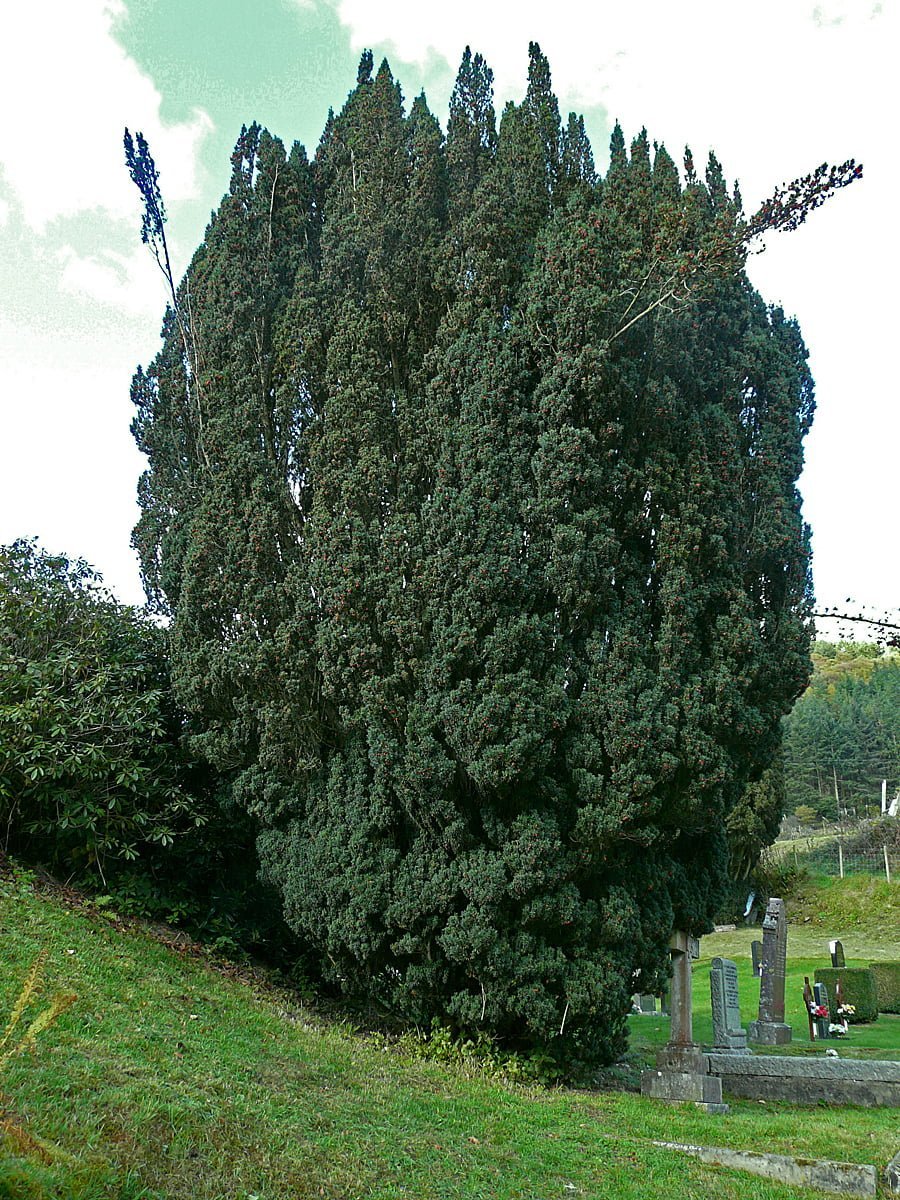
Here’s a detailed and verified chart for Irish Yew (Taxus baccata ‘Fastigiata’):
| Category | Details |
|---|---|
| Botanical Name | Taxus baccata ‘Fastigiata’ |
| Common Name | Irish Yew |
| Plant Name | Irish Yew |
| Zone | Typically zones 6-7 |
| Sun Exposure | Partial shade to full sun |
| Soil Type | Well-draining, fertile soil |
| Watering | Regular; prefers moist soil |
| Growth Habit | Evergreen shrub or small tree |
| Height/Spread | 10-20 feet tall, 3-5 feet wide (narrow columnar shape) |
| Special Features | Dense, upright growth habit; dark green needles; prefers cool climates and sheltered locations; used in formal gardens and as a specimen plant; toxic to humans and animals if ingested |
The Irish Yew is a special type of Yew tree. It grows straight up like a column, similar to the Italian Cypress.
This tree has dark green needles that grow all around its branches. It makes red berries that birds like to eat, but be careful – most parts of this tree are poisonous to people and pets.
Irish Yews are often used in formal gardens. They can be trimmed into neat shapes and stay green all year.
7. Indian Rosewood (Dalbergia sissoo)
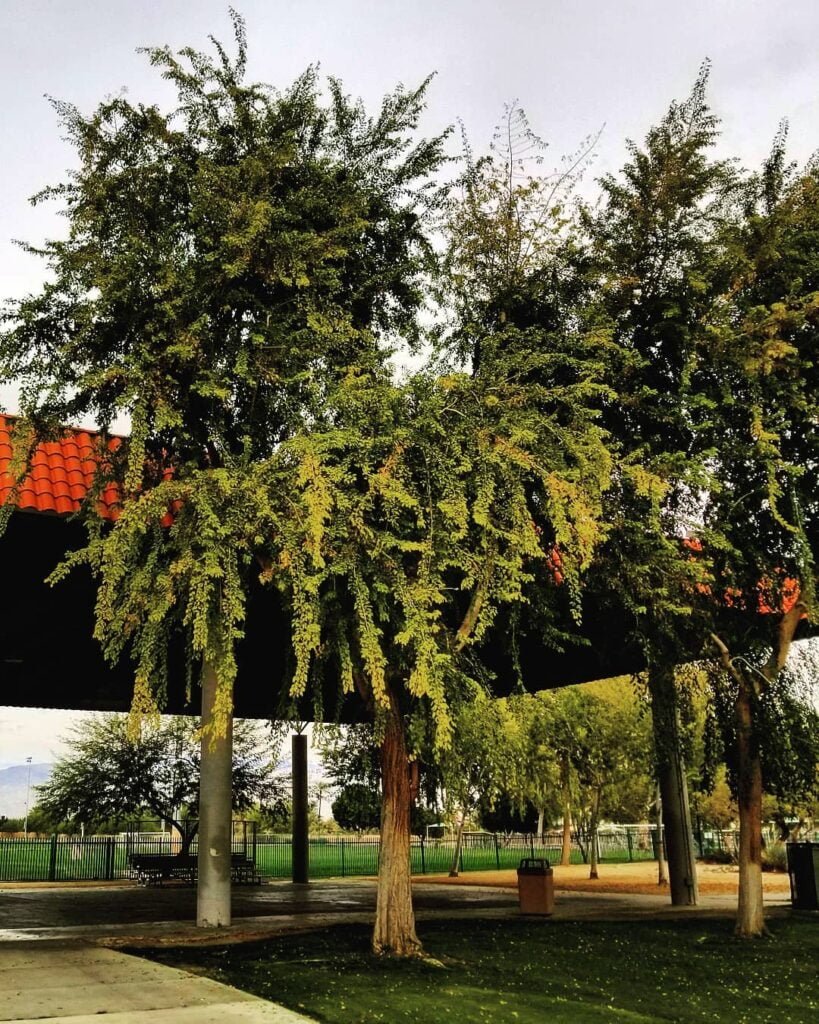
Here’s a detailed and verified chart for Indian Rosewood (Dalbergia latifolia):
| Category | Details |
|---|---|
| Botanical Name | Dalbergia latifolia |
| Common Name | Indian Rosewood |
| Plant Name | Indian Rosewood tree |
| Zone | Typically zones 10-12 |
| Sun Exposure | Full sun to partial shade |
| Soil Type | Well-draining, fertile soil |
| Watering | Regular; prefers consistently moist soil |
| Growth Habit | Deciduous tree |
| Height/Spread | Up to 100 feet tall, 30-40 feet wide |
| Special Features | Valuable timber species; dark brown heartwood used in furniture, musical instruments, and decorative items; fragrant flowers; tolerant of urban conditions and air pollution; important in agroforestry and reforestation projects |
Indian Rosewood is a tree known for its beautiful, dark wood. It grows naturally in India and nearby countries.
This tree has leaves made up of 3-5 smaller leaflets. It loses its leaves for a short time each year and then grows new ones.
The wood of Indian Rosewood is very valuable. People use it to make fancy furniture and musical instruments.
8. Ipe (Handroanthus)
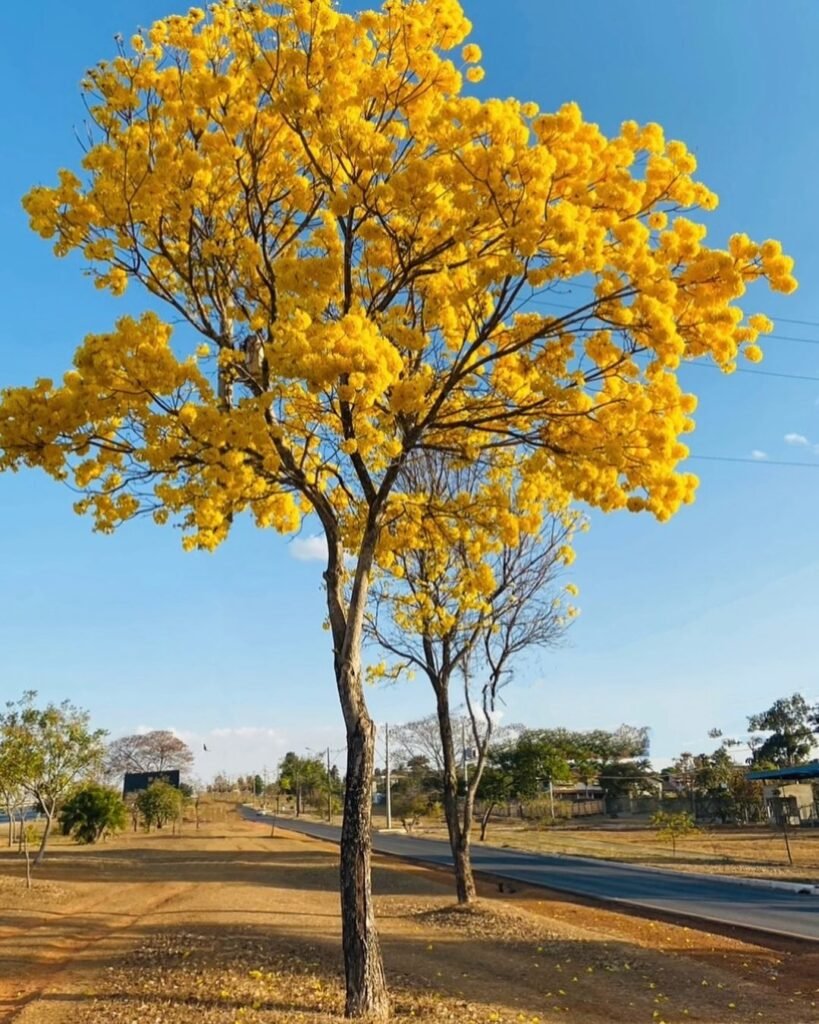
Here’s a detailed and verified chart for Ipe (Handroanthus spp., formerly known as Tabebuia spp.):
| Category | Details |
|---|---|
| Botanical Name | Handroanthus spp. |
| Common Name | Ipe, Brazilian Walnut |
| Plant Name | Ipe tree |
| Zone | Typically zones 10-11 |
| Sun Exposure | Full sun |
| Soil Type | Well-draining, sandy to loamy soil |
| Watering | Regular; drought-tolerant once established |
| Growth Habit | Evergreen or deciduous tree, depending on species |
| Height/Spread | 30-50 feet tall, 20-30 feet wide |
| Special Features | Extremely hard and durable wood used for outdoor decking, flooring, and furniture; attractive yellow to olive-brown wood with interlocking grain; yellow trumpet-shaped flowers in spring; tolerant of urban conditions and salt spray; important in reforestation efforts |
Ipe trees, also called Brazilian Walnut, are known for their super-hard wood. These trees grow in Central and South America.
Ipe trees have compound leaves made of 5-7 leaflets. They make beautiful pink, purple or yellow flowers in big clusters.
The wood from Ipe trees is so hard and durable that people use it for decks and outdoor furniture. It can last for many years without rotting.
9. Island Oak (Quercus tomentella)
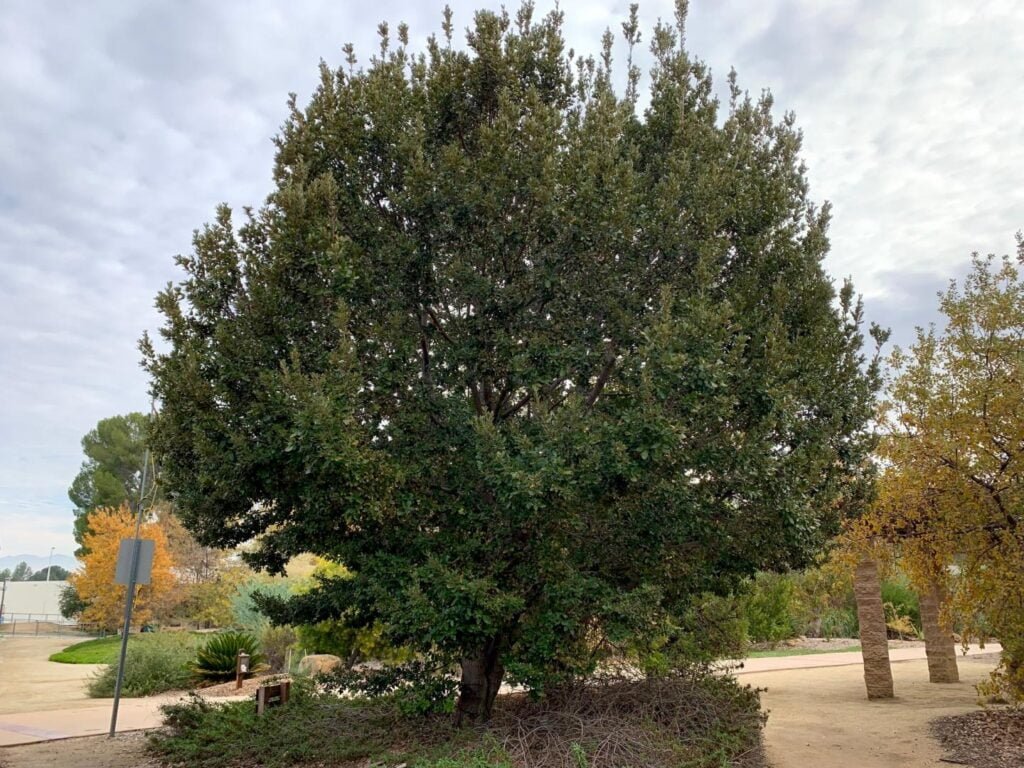
Here’s a detailed and verified chart for Island Oak (Quercus tomentella):
| Category | Details |
|---|---|
| Botanical Name | Quercus tomentella |
| Common Name | Island Oak |
| Plant Name | Island Oak tree |
| Zone | Typically zones 8-10 |
| Sun Exposure | Full sun |
| Soil Type | Well-draining, sandy or loamy soil |
| Watering | Moderate; drought-tolerant once established |
| Growth Habit | Evergreen or semi-evergreen tree |
| Height/Spread | 30-60 feet tall, 20-40 feet wide |
| Special Features | Native to Channel Islands of California; small, leathery leaves; tolerant of coastal conditions and wind; provides habitat for wildlife; valued for its ornamental and ecological roles |
The Island Oak is a rare tree that grows only on a few islands off the coast of California.
This oak has thick, leathery leaves that are woolly on the underside. It makes acorns that wildlife like to eat.
Island Oaks can live for a very long time. Some are thought to be over 500 years old!
10. Indian Beech (Pongamia pinnata)
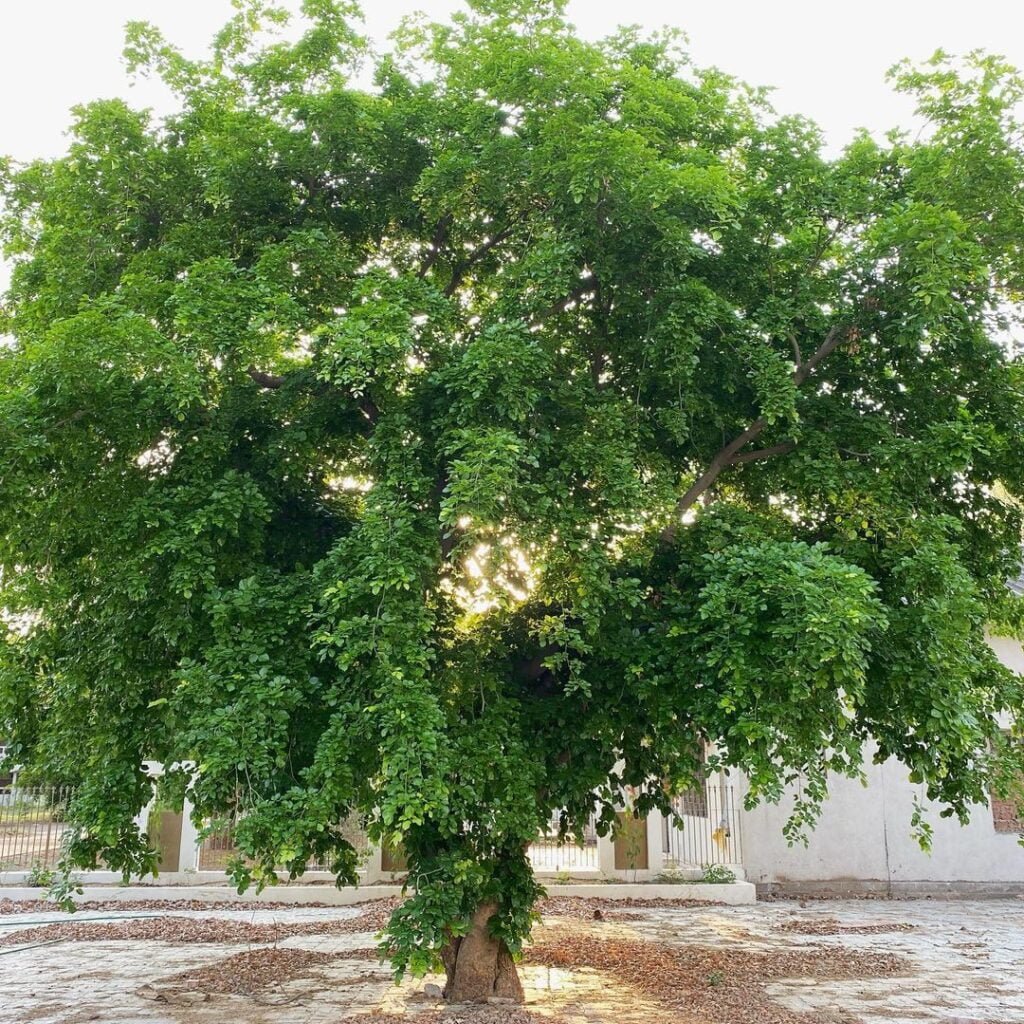
Here’s a detailed and verified chart for Indian Beech (Pongamia pinnata):
| Category | Details |
|---|---|
| Botanical Name | Pongamia pinnata |
| Common Name | Indian Beech, Pongam Tree |
| Plant Name | Indian Beech tree |
| Zone | Typically zones 10-11 |
| Sun Exposure | Full sun |
| Soil Type | Well-draining, sandy to loamy soil |
| Watering | Moderate; drought-tolerant once established |
| Growth Habit | Evergreen tree |
| Height/Spread | 30-50 feet tall, 20-40 feet wide |
| Special Features | Produces clusters of pink to purple flowers; seeds contain oil used for biofuel and traditional medicine; nitrogen-fixing properties improve soil fertility; tolerant of coastal conditions and urban environments; important in agroforestry and reforestation projects |
The Indian Beech, also called Pongam, is a medium-sized tree that grows in tropical areas. It’s native to India and Southeast Asia.
This tree has large, shiny leaves and makes clusters of pink or white flowers. It produces beans that look a bit like flat lima beans.
People use oil from Indian Beech seeds to make biodiesel fuel. The tree is also used in traditional medicine.
11. Ilama (Annona diversifolia)
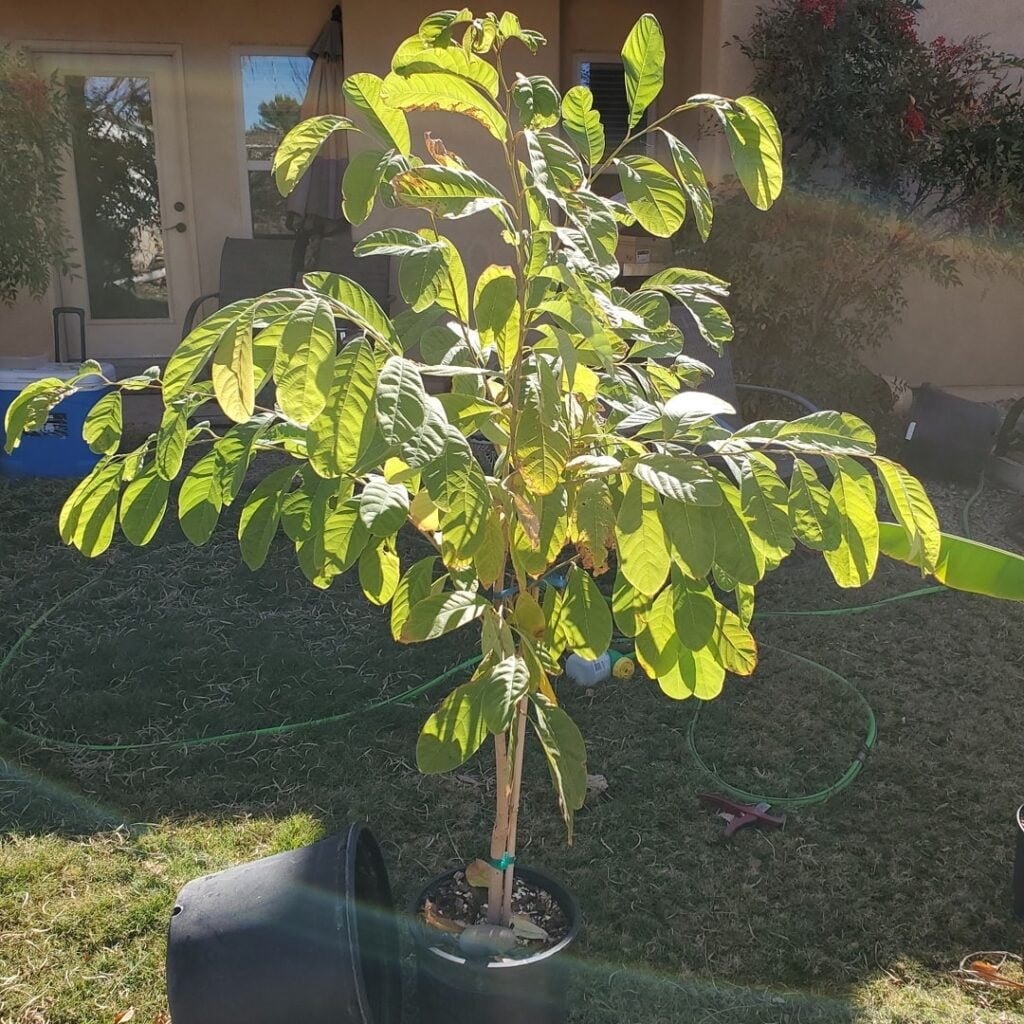
Here’s a detailed and verified chart for Ilama (Annona diversifolia):
| Category | Details |
|---|---|
| Botanical Name | Annona diversifolia |
| Common Name | Ilama |
| Plant Name | Ilama tree |
| Zone | Typically zones 10-11 |
| Sun Exposure | Full sun |
| Soil Type | Well-draining, fertile soil |
| Watering | Regular; prefers consistently moist soil |
| Growth Habit | Evergreen tree |
| Height/Spread | Up to 30-40 feet tall, 20-30 feet wide |
| Special Features | Produces edible fruits with sweet, custard-like flesh; adapted to tropical climates; requires protection from frost; valued for its fruit production and ornamental qualities |
The Ilama is a fruit tree from Central America. It’s related to the Cherimoya and Soursop.
This tree has large, oval leaves and makes interesting flowers that look like they’re made of thick, waxy petals.
The fruits of the Ilama are big and heart-shaped. They have sweet, white flesh that tastes a bit like a mix of banana and pineapple.
12. Inkberry (Ilex glabra)

Here’s a detailed and verified chart for Inkberry (Ilex glabra):
| Category | Details |
|---|---|
| Botanical Name | Ilex glabra |
| Common Name | Inkberry |
| Plant Name | Inkberry |
| Zone | Typically zones 4-9 |
| Sun Exposure | Full sun to part shade |
| Soil Type | Moist, well-draining soil |
| Watering | Regular; prefers moist soil |
| Growth Habit | Evergreen shrub |
| Height/Spread | 3-8 feet tall, 3-6 feet wide |
| Special Features | Dark green foliage; produces small black berries; tolerant of wet soils and salt spray; used in landscaping for hedges and borders; provides cover and food for wildlife |
Inkberry is a type of Holly. It’s a small tree or large shrub that stays green all year.
This plant has small, dark green leaves with smooth edges. It makes tiny white flowers and black berries.
Inkberry is great for gardens because it’s tough and can grow in many different conditions. It’s also good for wildlife – birds eat the berries and deer don’t like to eat the leaves.
13. Indian Almond (Terminalia catappa)
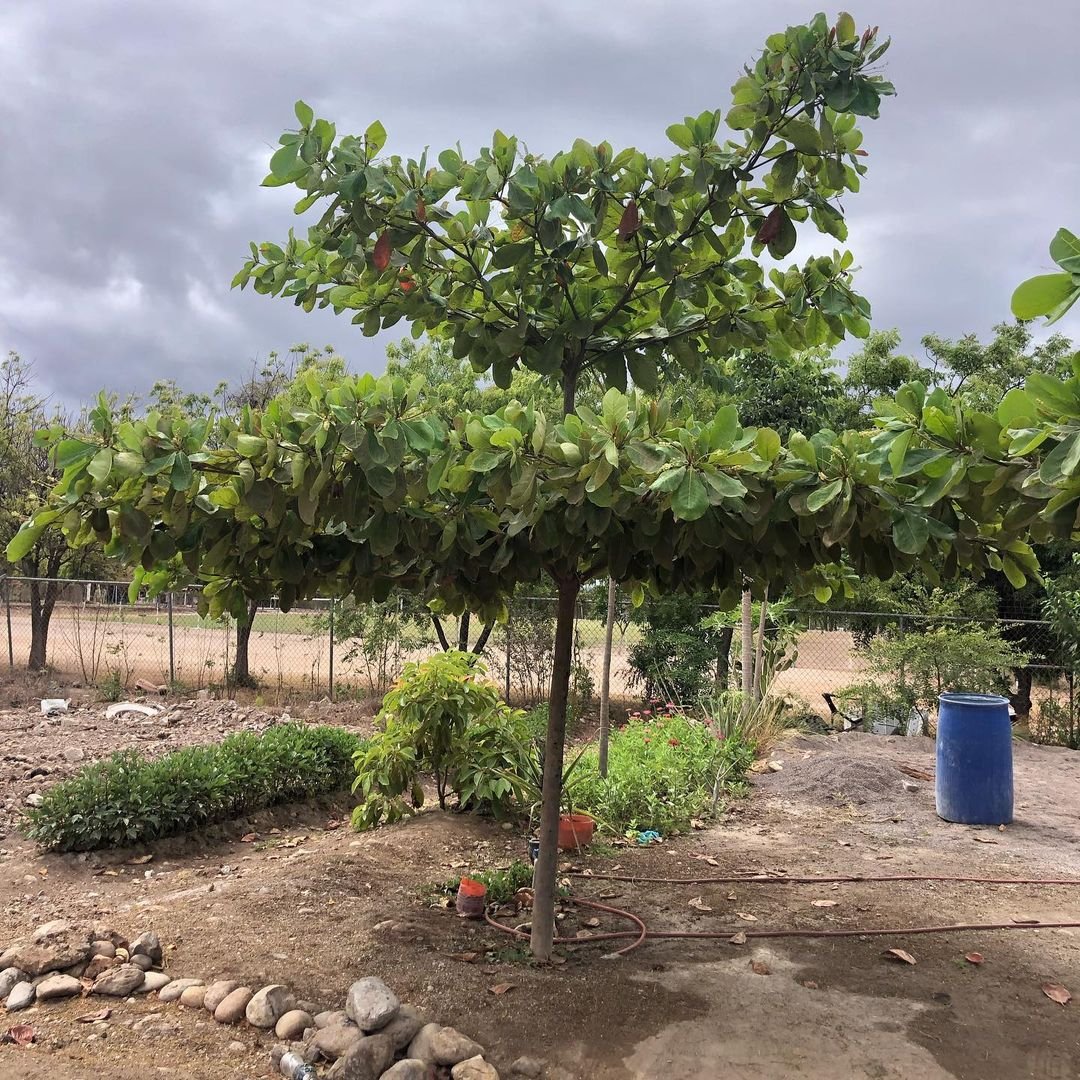
Here’s a detailed and verified chart for Indian Almond (Terminalia catappa):
| Category | Details |
|---|---|
| Botanical Name | Terminalia catappa |
| Common Name | Indian Almond |
| Plant Name | Indian Almond tree |
| Zone | Typically zones 10-12 |
| Sun Exposure | Full sun to partial shade |
| Soil Type | Well-draining, sandy to loamy soil |
| Watering | Moderate; drought-tolerant once established |
| Growth Habit | Evergreen tree |
| Height/Spread | 50-70 feet tall, 30-50 feet wide |
| Special Features | Large, broad leaves that turn red or yellow before dropping; produces edible nuts (almonds); salt-tolerant and commonly found along tropical coasts; provides shade and habitat for wildlife; used in traditional medicine and cultural practices |
The Indian Almond, also called Tropical Almond, is a big tree that grows near tropical coasts.
This tree has large, leathery leaves that turn pretty red or yellow colors before falling off. It makes fruits that look like almonds but aren’t related to true almonds.
People eat the nuts from Indian Almond trees and the leaves and bark are used in traditional medicine.
14. Ivory Palm (Phytelephas)

Here’s a detailed and verified chart for Ivory Palm (Hyophorbe verschaffeltii):
| Category | Details |
|---|---|
| Botanical Name | Hyophorbe verschaffeltii |
| Common Name | Ivory Palm |
| Plant Name | Ivory Palm |
| Zone | Typically zones 10-11 |
| Sun Exposure | Full sun to partial shade |
| Soil Type | Well-draining, sandy soil |
| Watering | Regular; drought-tolerant once established |
| Growth Habit | Evergreen palm tree |
| Height/Spread | Up to 20-30 feet tall, 5-10 feet wide |
| Special Features | Distinctive ivory-colored trunk with prominent rings; feather-like fronds; slow-growing; requires protection from strong winds; often used in tropical and subtropical landscapes as an ornamental focal point |
The Ivory Palm is an unusual palm tree from South America. It doesn’t have a tall trunk like most palms.
This palm makes very large seeds. The insides of these seeds are hard and white, like ivory. People use them to make buttons and small carved items.
Ivory Palms grow slowly and need a warm, wet climate. They’re important to the ecosystems where they grow naturally.
15. Illawarra Flame Tree (Brachychiton acerifolius)

Here’s a detailed and verified chart for the Illawarra Flame Tree (Brachychiton acerifolius):
| Category | Details |
|---|---|
| Botanical Name | Brachychiton acerifolius |
| Common Name | Illawarra Flame Tree |
| Plant Name | Illawarra Flame Tree |
| Zone | Typically zones 9-11 |
| Sun Exposure | Full sun |
| Soil Type | Well-draining, fertile soil |
| Watering | Regular; drought-tolerant once established |
| Growth Habit | Deciduous tree |
| Height/Spread | 30-50 feet tall, 20-30 feet wide |
| Special Features | Brilliant display of red bell-shaped flowers in spring; large, lobed leaves resembling maple leaves; drought-tolerant once established; provides shade and ornamental value in gardens; native to eastern Australia |
The Illawarra Flame Tree is a beautiful tree from Australia. It gets its name from its bright red flowers that cover the tree when it blooms.
This tree loses its leaves before it flowers, so the whole tree looks like it’s on fire when it’s covered in red blooms.
Illawarra Flame Trees are often planted in parks and gardens in warm areas because they’re so pretty when they flower.
How to Plant and Care for ‘I’ Trees
Now that we know about these cool ‘I’ trees, let’s talk about how to plant and care for them:
- Choose the right tree: Make sure the tree you pick will fit in your yard when it’s fully grown.
- Check your climate: Some ‘I’ trees like warm weather, others can handle cold. Pick a tree that will be happy where you live.
- Prepare the soil: Most trees like soil that drains well. Mix in some compost to help your tree grow strong.
- Plant carefully: Dig a hole twice as wide as the root ball but just as deep. Place the tree at the same level it was in its pot.
- Water well: New trees need lots of water. Keep the soil moist but not soggy.
- Add mulch: Put a layer of mulch around your tree to keep the soil moist and stop weeds from growing.
- Prune when needed: Cut off dead or damaged branches to keep your tree healthy and looking nice.
For more tree planting tips, visit the Arbor Day Foundation website.
Why Plant Trees?
Planting trees is good for many reasons:
- Trees clean our air by taking in carbon dioxide and giving out oxygen.
- They provide homes and food for birds and animals.
- Trees can help save energy by shading our homes in summer.
- They make our neighborhoods look prettier.
- Some trees give us fruits or nuts to eat.
- Trees help stop soil from washing away when it rains hard.
Trees that start with ‘I’ are amazing! From the tall Italian Cypress to the sweet-smelling Indian Sandalwood, these trees make our world more beautiful and interesting.
When you plant a tree, you’re doing something good for the Earth and for future generations. Why not think about planting an ‘I’ tree in your yard?
Remember, every tree needs care to grow strong and healthy. With some love and attention, you can have a beautiful tree that will bring joy for many years.
Whether you choose a big Indian Laurel for shade or a pretty Illawarra Flame Tree for flowers, you’re sure to find an ‘I’ tree that’s perfect for you. Happy planting!
Pingback: https://gardenersschool.com/trees-that-start-wi...